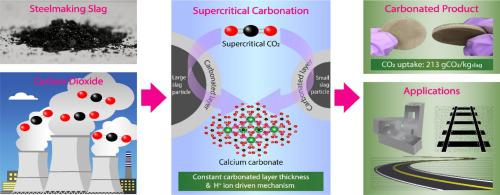Journal of CO2 Utilization ( IF 7.7 ) Pub Date : 2021-08-04 , DOI: 10.1016/j.jcou.2021.101667 Jihye Kim 1 , Gisele Azimi 1, 2

|
The current study puts the emphasis on developing a supercritical carbonation process of electric arc furnace slag for the CO2 sequestration. In this process, the feed is mixed with water and processed with supercritical CO2 at 40−80 °C and 80–120 bar for 48 h. This process offers several advantages including higher reactivity, faster kinetics, less waste generation, better economic feasibility, and less pretreatment compared with aqueous carbonation. The empirical model established by using a systematic design of experiments methodology is demonstrated to be suitable for calculating the carbonation efficiency as a function of operating parameters and performing the process optimization. With fundamental investigations into carbonation mechanisms, the slag particle size is determined to have the most significant positive impact on carbonation efficiency. The sample with a smaller particle size has a higher total carbonated volume, resulting in higher CO2 uptake. Fundamental investigations into the carbonation process indicate that the diffusion barrier to the carbonation process is a product calcium carbonate layer formed on the outer shell of the slag particle and the thickness of this layer is constant regardless of the slag particle size. Furthermore, it was revealed that the reaction mechanism of the carbonation process is mainly driven by the hydrogen ion which reacts with dicalcium silicate in EAF slag and produces dissolved calcium ions. In this study, the reaction pathway for supercritical carbonation of EAF slag is elucidated and the results of mechanistic investigations shed light on the diffusion barrier to the carbonation process and the rate-determining step. We expect the results of this study help enable the carbonation of industrial byproducts, in particular, steelmaking slag.
中文翻译:

电弧炉渣超临界碳化封存CO2
目前的研究重点是开发用于封存CO 2 的电弧炉渣超临界碳化工艺。在这个过程中,进料与水混合并用超临界 CO 2 处理在 40-80 °C 和 80-120 bar 下保持 48 小时。与水性碳酸化相比,该工艺具有多种优势,包括更高的反应性、更快的动力学、更少的废物产生、更好的经济可行性以及更少的预处理。通过使用系统的实验设计方法建立的经验模型被证明适用于计算作为操作参数函数的碳酸化效率和进行工艺优化。通过对碳化机制的基本研究,确定炉渣粒度对碳化效率具有最显着的积极影响。具有较小粒径的样品具有较高的总碳酸化体积,导致较高的 CO 2摄取。对碳化过程的基本研究表明,碳化过程的扩散屏障是在渣颗粒外壳上形成的产物碳酸钙层,无论渣颗粒大小如何,该层的厚度都是恒定的。此外,揭示了碳酸化过程的反应机理主要是由氢离子驱动的,氢离子与电炉渣中的硅酸二钙反应并产生溶解的钙离子。在这项研究中,阐明了 EAF 炉渣超临界碳化的反应途径,并且机理研究的结果阐明了碳化过程的扩散障碍和速率决定步骤。我们希望这项研究的结果有助于实现工业副产品,特别是炼钢炉渣的碳化。



























 京公网安备 11010802027423号
京公网安备 11010802027423号